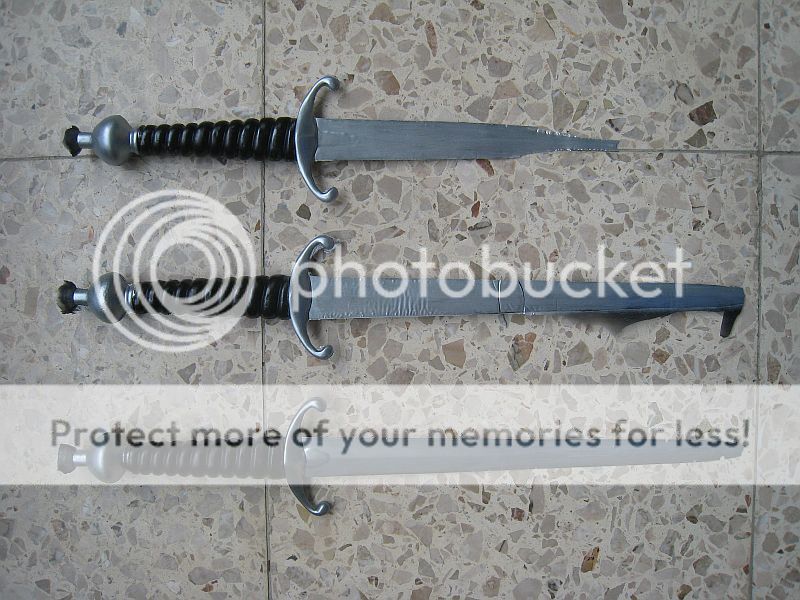ewigestuden
Member
Hello!
I realize more and more that it's quite a challenge to put together an accurate V costume so many years after the movie. Especially nice con-safe daggers are really hard to come across, so I decided to take matters in my own (most incapable, noobish) hands
After having read and watched tons of Smooth-On tutorials and specs, I decided to use OOMOO for the 2-part mold and Smooth-Cast ONYX for the replica.
Here are some pics:


Doesn't look too bad for the first try, BUT.
I've encountered some problems and I would really appreciate an advice
Firstly, my original dagger demolded when I was removing clay from the first half of the mold. I will be making another mold because the present one is not so nice on one side due to that demolding. How do I do it better next time? Is it about having the simplest rectangular box to minimize shifting the half-mold around while repositioning and removing clay? And there I thought I was being smart saving the silicone with that tailored mold box :facepalm
Then the main problem: the blade thickness of the original is 2 mm and one of my replica might be even less over the length of 30 cm. I took the resin with the Shore Hardness 80 in hopes to achieve stability despite that thin blade. Well, I was wrong. The blade of the replica is disapointingly flexible. Is there a different resin with a much higher hardness and still low viscosity that would fit better for this project?
And last but not least - I placed the replica into the oven as suggested in the product sheet, in hopes of achieving a better hardness. The picture above shows clearly that warming the replica up resulted only in bubbles - they were not visible after demolding! I know that I have to pour the resin into the mold slower to prevent bubbles from building, but it's sort of disappointing to see more bubbles appear while post curing. Is anybody here doing post curing at all? Does it do anything apart from bringing up bubbles?
Many thanks in advance for any and each advice! I will be ordering more silicone tomorrow and I would be really happy to add to my order if anybody has an idea for different resins to use here.
cheers
e.
Edit:
Am I wrong looking for a resin with a higher hardness to get a less flexible blade? Maybe it's the tensile strength that matters in this case? :confused
I realize more and more that it's quite a challenge to put together an accurate V costume so many years after the movie. Especially nice con-safe daggers are really hard to come across, so I decided to take matters in my own (most incapable, noobish) hands
After having read and watched tons of Smooth-On tutorials and specs, I decided to use OOMOO for the 2-part mold and Smooth-Cast ONYX for the replica.
Here are some pics:


Doesn't look too bad for the first try, BUT.
I've encountered some problems and I would really appreciate an advice
Firstly, my original dagger demolded when I was removing clay from the first half of the mold. I will be making another mold because the present one is not so nice on one side due to that demolding. How do I do it better next time? Is it about having the simplest rectangular box to minimize shifting the half-mold around while repositioning and removing clay? And there I thought I was being smart saving the silicone with that tailored mold box :facepalm
Then the main problem: the blade thickness of the original is 2 mm and one of my replica might be even less over the length of 30 cm. I took the resin with the Shore Hardness 80 in hopes to achieve stability despite that thin blade. Well, I was wrong. The blade of the replica is disapointingly flexible. Is there a different resin with a much higher hardness and still low viscosity that would fit better for this project?
And last but not least - I placed the replica into the oven as suggested in the product sheet, in hopes of achieving a better hardness. The picture above shows clearly that warming the replica up resulted only in bubbles - they were not visible after demolding! I know that I have to pour the resin into the mold slower to prevent bubbles from building, but it's sort of disappointing to see more bubbles appear while post curing. Is anybody here doing post curing at all? Does it do anything apart from bringing up bubbles?
Many thanks in advance for any and each advice! I will be ordering more silicone tomorrow and I would be really happy to add to my order if anybody has an idea for different resins to use here.
cheers
e.
Edit:
Am I wrong looking for a resin with a higher hardness to get a less flexible blade? Maybe it's the tensile strength that matters in this case? :confused
Last edited:





